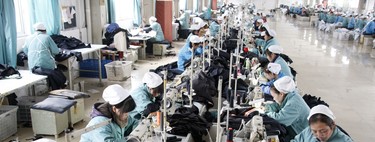China is experiencing a perfect storm in which its foundations are shaking economicsocial and labor. The problem is not new to Europe or the United States: young people and his disaffection for the “culture of effort” in a society that suffocates them without giving them many expectations for the future.
The ups and downs of cyclical capitalism. Like people, each economy is a world of its own and simplification is always reckless. Even so, it is easy to recognize in today’s Asian youth the European and North American youth of the 1990s, who were well prepared and did not resign themselves to the precarious salary of an assembly line with a PhD in their pocket.
During the 1990s and 2000s, two factors contributed to the relocation of “the world’s factories” to the Asian continent: on the one hand, the improvement in wage conditions in Western countries and, on the other, the entry of China and later other countries into the World Trade Organization. “Offshoring” brought the world’s industry to countries such as Vietnam, Cambodia, Thailand, Bangladesh and, of course, China.
The start of the Asian locomotiveWith low wages and limited labour rights, China became the world’s Big Factory. The Chinese manufactured everything at a lower cost. Neither the emissions of the industry nor the training of employees were taken into account. All that mattered was producing with cheap labour and keeping the economy growing at a cruising pace.
Those first young workers had barely any education, but they did have the responsibility of earning a salary to support their family. Like any father or mother, they were not going to allow their children to live in the same conditions as they did by providing them with a good education.
The generational change rebelsBetter educated than their parents, with more comfortable lives and without the added responsibility of having to feed a family, young people in Southeast Asia no longer want to take the jobs their parents occupied. Even more so after years of seeing the working conditions their parents endured.
The problem is now on the shoulders of Asian companies, which are on a par with the rest of the world: a shortage of qualified personnel, increasingly difficult to retain talent, higher production costs and poorer working conditions. The number of new graduates in China this year is 11.6 million young people ready to enter the labour market.
China copies the West’s policiesFor decades, Chinese manufacturers have been accused of copying Western patents to make inferior products. This time, companies are trying to copy the business models of large companies such as Apple and Google to try to attract and retain qualified talent for their ageing workforces.
Workplaces across Asia are knocking down walls and opening large windows to let in natural light. Childcare facilities, cafeterias with free food for employees, and even leisure and break spaces are being introduced. All in order to attract those new engineers, PhDs and developers feel comfortable in the factory. Some factories have even moved to rural areas to attract young workers who are not willing to migrate to big cities.
Young people do not want to workYouth unemployment in China is a serious problem, reaching a rate of 21.3% during the past month of June for those under 25 years of age. China has more than 96 million young people under 25 years of age and more than 33 million have entered the labour market. In Spain, according to the Active Population Survey (EPA) In the last quarter, the unemployment rate for people under 25 was 30.03%.
These figures indicate that there is a large number of young people looking for workand every year a huge number of recent graduates are added to the labour market. The problem, as in much of the Western world, is the low wages and long working days.Young Chinese people have had enough and have adopted Joe Biden’s famous words: “Pay them more.”
The locomotive now has to pay for the coal. Keeping the production of The Big Factory that Asia in general, and China in particular, has become running requires an enormous amount of manpower. However, unlike their parents, the young people of 2023 will already be They are graduates and are looking for a salary that suits them..
This leads to increased costs and brands are already starting to relocate their production facilities. Mattel, creator of the popular Barbie, manufactured 74% of its toys in China, Indonesia and Thailand. With the rising costs, has moved much of its production to new factories in Brazil and Mexico. The same example can be found in technology, with Apple at the forefront, where the blockade of Chinese products has put the final nail in the coffin for the transfer of its production to India or other countries.
The perfect StormThe demographic crisis, in which China is losing population for the first time in 60 years, is joined by the labor crisis and a economic situation seriously affected after the blockade of the aggressive management of the COVID-19 pandemic. Everything is generating a perfect storm for the country to lose global weight with falls in exportsThe Great Asian Factory is sinking and low-cost production is numbered.
At Xataka | Not only iPhones come out of Foxconn’s factories, but also electric motorcycles that cost $9,400
At Xataka | After years of being “the world’s factory”, a country is about to take over from China: Vietnam
Image | Pixabay
*A previous version of this article was published in August 2023





![[Img #74683]](https://thelatestnews.world/wp-content/uploads/2024/12/The-main-mistakes-to-avoid-when-betting-on-electronic-sports-150x150.jpg)







![[Img #74683]](https://thelatestnews.world/wp-content/uploads/2024/12/The-main-mistakes-to-avoid-when-betting-on-electronic-sports-300x200.jpg)


Add Comment